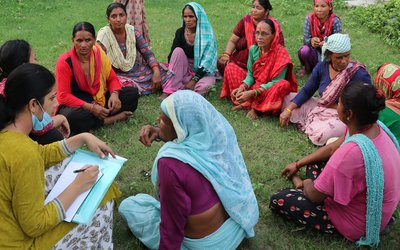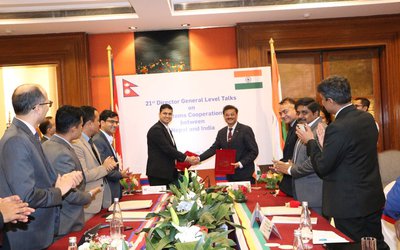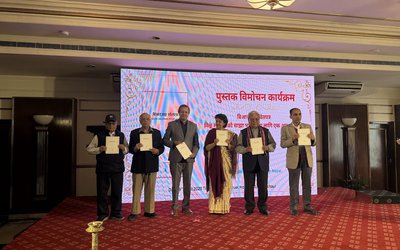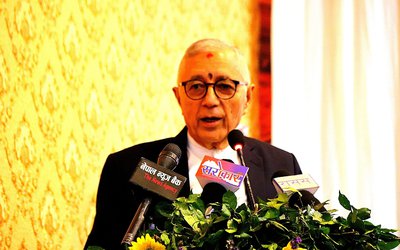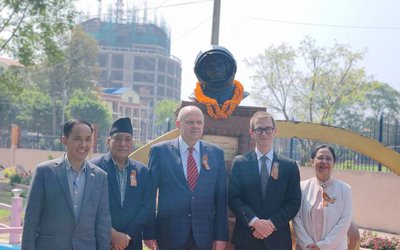
The 21st Conference of Parties (COP) in Paris in 2015 built the momentum in which 147 parties ratified the Paris Agreement to act to minimize the impacts of climate change and keep the global temperature rise well below 2ºC. Countries submitted their INDCs (Intended National Determined Contributions) prior to the conference, which entailed either mitigation actions or both adaptation and mitigation actions. The INDC were later upgraded to NDC (Nationally Determined Contributions) post the Paris Meeting.
Nepal too submitted its INDCs to the UNFCCC in October 2015, which was later upgraded to NDCs. Nepal’s NDCs identifies the sectors to cover both adaptation and mitigation actions and the level of support needed (both technical and financial) for it to progress and build its resilience towards climate change.
Nepal is among the climate vulnerable countries in the world and with an agrarian economy that depends on the monsoons and with a fragile physiography, puts its overall social and economic development at stake. However, given the new governance structure as per its new constitution promulgated in September 2015 that decentralizes power at the local level, provides an opportunity for Nepal to rethink climate smart development across the 744 municipalities and rural municipalities.
Adaptation is key for all local communities, indigenous people, women and children, as it is about survival. The Government of Nepal has also allocated funds in relation to climate change for the coming fiscal year (2017-2018) of which 4% is highly relevant and 26% is relevant; but at the same time the budget also focusses highly on development through mega infrastructures, thus it is critical that we ensure our development mainstreams climate change and that we tread low carbon development pathways as we adapt to the changes.
Nepal has been an energy deficient country for the past nearly two decades, and suddenly in 2016, we have the scenarios of a balanced energy supply and demand situation. Initially given the high investment costs on renewables, industries and enterprises took up to fossil fuel. Nearly 40% of the diesel was consumed in the capital for electricity generation. With time and the decreasing costs of solar energy, citizens of Nepal did take up to diversifying the energy mix and switching to solar and in some place wind as well. But suddenly with the energy sufficiency, the diversification of the energy mix was at stake. People and the country are again fully reliant on the imported energy from India. The diversification should continue as this opens doors for self-energy reliance and reducing the costs of energy consumption. Energy efficiency is also playing a key role with energy efficient appliances and lighting technologies evolving from fluorescent lamps to CFLs to now LEDs. All of this contributes to lowering energy demands and costs and increasing self-sufficiency.
Besides the energy sector, the transport sector is also an important sector where there lie great opportunities for change. Policies are in place to promote e-vehicles, but there are no infrastructures in place to promote the full functioning of e-vehicles. Countries like Germany and India have already pledged for decarbonizing the transport sector; Nepal too could take a step forward to make this big change. We have seen e-vehicle (three wheelers and four wheelers) ply in the road. But in a country where we must depend on imported fossil fuels and imported vehicles, why can’t there be a step to go for 100% e-vehicles progressively in the years to come given that we expand the renewable energy mix and build on our self-reliance for energy and energy efficiency.
Similarly, our kitchens too took can go e-cooking with power supplied from the diversification of energy rather than full relying on imported LPGs and kerosene. Biogas in the sub-urban and rural areas have already played an exemplary role on the switch to renewables, reducing or completely not using fuel wood. The cost of Induction cookers and vessels are also not that expensive if one would consider the switch.
Climate change brings about so much uncertainties. Nothing is predictable and consistent because of climate change. A recent example of the region, deadly floods in Sri-Lanka, the devastating cyclone Maro hitting Bangladesh and the expected delay in the 2017 monsoons in Nepal all at the same time. At the end of the day we must also fight our own battle; we need to allocate sufficient resources, take up risk reduction measures across all sectors and strengthen preparedness at all levels in addition to the international support to better prepare for climate change. This finally leads to the context that Nepal should strategize to looking at balancing both adaptation and mitigation actions and plan climate smart development in the context of its new governance structures that is being functional.
-Ugan Manandhar is a Deputy Director: Climate and Energy, WWF Nepal




